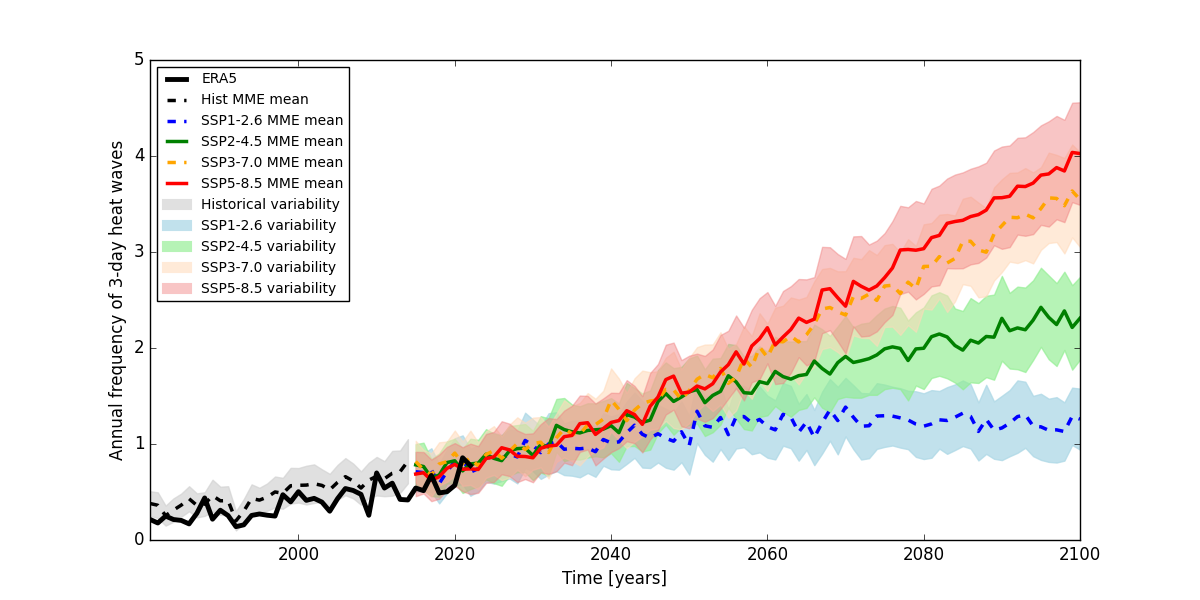There’s evidence that our dreams serve a purpose of preparing us for difficult situations in our waking lives. They train us to react to situations. The same is true for climate change scenarios. They serve the purpose of preparing us for a range of possible futures, even if none of these futures will come to pass.
You might be thinking: “My dreams are almost always ludicrous, they can’t possibly be preparing me for real-world situations. I mean, following instructions from a talking alligator to build a magical compass? What’s that preparing me for?”
No? Just me, then.
Anyway, climate scenarios are also sort of ludicrous. The most recent scenarios, which are called Shared Socioeconomic Pathways (SSP), are estimates of the amount of greenhouse gas emissions under a series of interconnected aspects of society. For example, starting from current numbers on population, urbanization, and GDP, we can imagine how greenhouse gas concentrations will change based on the logical relationships between these numbers and other factors, such as emerging technologies, deforestation, and political policies. We can dream of a world where things get progressively worse, a world where they get progressively better, and everything in between. More importantly, we can be prepared to react to what the future holds.
I want to emphasize that these scenarios are not simply wild guesses. They are envisioned by a team of very smart people (climate scientists, economists and energy systems modelers) and based on our best understanding of a complex society ever growing in complexity. But the reality is that no scenario is the truth. We are probably going to take several of these paths at one point or another.
Once we have the estimates of greenhouse gas emissions, we can feed this information to climate models and get simulations of what the future climate might look like under those conditions. These climate models are similar versions of the atmospheric models that we use to forecast the weather, only combined with other models that simulate the behavior of the oceans, land and ice processes, and sometimes additional models, such as models that simulate chemical reactions in the environment. Here’s an example of a climate risk analysis done by our team for the contiguous United States. This is what the annual frequency of heat waves lasting at least three consecutive days might look like under four of the main SSP scenarios.

Figure 1 – Annual frequency of heat waves (at least three consecutive days). The gray shading represents the variability of simulations (+ or – one standard error of the mean across all models considered) for the present climate and validated against ERA5. The figure includes the climate change projections for four of the main SSP scenarios, including: SSP1, Sustainability (Taking the Green Road); SSP2, Middle of the Road; SSP3, Regional Rivalry (A Rocky Road); and SSP5, Fossil-fueled Development (Taking the Highway). More about the SSP scenarios can be found here.
Note that all projections show more or less the same results until around 2040. That is the effect of emissions that have already taken place, unavoidable warming. Beyond 2040 the frequency of heat waves follow different paths. The most optimistic path would keep heat wave frequency at the same levels as the decade of 2040, but other scenarios suggest that this phenomenon can become much more frequent by the end of the century.
In science, nothing is a certainty, everything is likely at a certain confidence level. In other words, science cannot offer absolute truths and that is how it is supposed to work. One of the main roles of a climate scientist is to inform society of what the climate is likely to be in the future. Not only ten, twenty, a hundred years from now, but also next month, next season. We all benefit from climate science everyday. Our water supply, the energy that power our houses, the food at our tables are all impacted by the climate. If not directly, by phenomena such as prolonged droughts and crop failures, at least indirectly through the cost of water, energy, and food as a result of intricate relationships in global markets. What we climate scientists do is give you the premises of the dream. It’s your job to navigate it.



